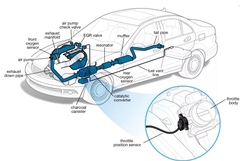
When you step on the accelerator, you expect your vehicle to speed up, not slow down. But, what if it doesn’t? That can be a big problem.
The answer may be a problem with the sensor that helps your vehicle determine that the proper mix of air and fuel for your engine. It's called the TPS, or Throttle Position Sensor. Here's how it works.
Your vehicle’s throttle opens when you need more air to accelerate and closes when you need less. The throttle position sensor does pretty much what its name says: it senses the position of the throttle. That reading, along with air flow measurements, is sent to the vehicle's computer. The computer factors in air temperature, how fast the engine is turning over, and air flow to determine how much fuel to supply the engine. If everything's working correctly, you'll get the acceleration you want along with the fuel economy you expect.
However, if the TPS fails, your vehicle won’t accelerate properly or have the power you expect when you push down on the accelerator pedal. Your vehicle could even accelerate on its own. Another symptom could be reduced engine power. You also may see your Check Engine light come on.
If you notice any of these signs, it's wise to get to Auto Select soon. When your TPS stops working correctly, it can leave you behind the wheel of a vehicle that is not safe to drive. In case of a total TPS failure, most vehicles have a "limp home" or "limp in" mode that will allow you to at least get off the road to a safer spot.
Your qualified technician can diagnose the problem and install the correct TPS replacement part. The new unit may need to be reprogramed to work in harmony with other software in your vehicle.
Let's face it; computers are a big part of today's vehicles. It's important to keep them—and the sensors that provide them information—working right so you can travel safely down the road.